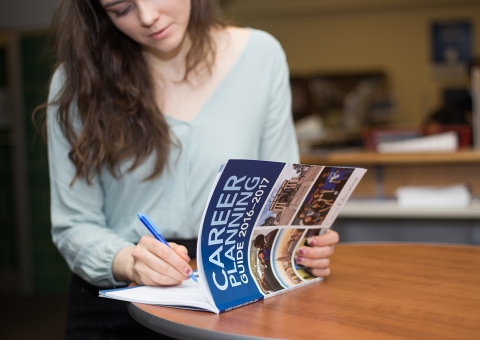 Student working in career planning guide" width="480" height="340" />
Student working in career planning guide" width="480" height="340" /> Student working in career planning guide" width="480" height="340" />
Student working in career planning guide" width="480" height="340" />
A cover letter is a one-page business letter that you submit when applying to a job, along with your resume. As a piece of persuasive writing, your cover letter will aim to convey to the employer why you’re a great candidate for the role.
Your cover letter complements your resume by making it easy for the employer to see how your experience and interest connect to the position. Your goal is to convince the employer to interview you.
With your cover letter, you’ll aim to:
Not all jobs require cover letters. So, how do you decide whether to submit one?
If you’re applying to several similar opportunities, creating a draft cover letter in advance, geared toward that type of opportunity, can be a helpful way to save time in your actual application process.
Your cover letter should articulate your qualifications and motivation for the position. Read the job description closely and research the organization. As you craft your cover letter, use examples that demonstrate your relevant skills, knowledge, and interests. The cover letter should be concise, clear, and well-organized.
Learn enough about the organization to articulate why you are a strong fit for that firm.
Look for skills, duties, and qualifications of the job so you can design your letter to match these as much as possible.
Identify skills and personal qualities you have developed which will be useful in this role. Ask yourself:
As a business letter, the cover letter should include:
The cover letter should be one page, about three or four paragraphs, and single spaced. Use 10-12 point font and one inch margins.
When applying online, upload your cover letter as a PDF file, unless another format is specified. When sending your resume and cover letter by email, you may write a short note or paste your cover letter in the body of your email (without the address header) and also attach the PDF file.
Your cover letter should answer who, what, when, where and why you are applying for the opportunity.
State the position for which you are applying. If you have a referral or spoke with someone from the company, you can mention it in the introduction. Provide some basic information about yourself; this can include your class year and what you’re studying at Columbia. Briefly outline why you’re interested in the organization and what you bring in terms of relevant experience and skills.
These paragraphs will highlight your qualifications and strengths that are most relevant to the organization and position. Use the job posting and your research as clues to determine what the employer is seeking in a candidate. Have your resume beside you and reflect on what you want the employer to know about you. Are there experiences you want to expand upon that demonstrate your understanding of the role and ability to do the job requirements?
Structure the paragraphs based on relevance, not chronology. Lead with your most relevant skill or strongest experience.
Start each body paragraph with a clear topic sentence. This can highlight a key skill set, a transferable experience, or a core area of knowledge you’ve built through your studies. Walk the reader through a project or experience, integrating the relevant skills you used and qualities you demonstrated. Provide details about your accomplishments and impact. Connect how these experiences have prepared you for this role and why you are motivated to do this job. There is no need to apologize if you feel you lack experience; focus on the accomplishments that you have.
Recap what you would bring to the organization and your interest in the position. Thank the employer for their consideration. Keep your tone positive and enthusiastic.
Use our Cover Letter Checklist to make sure your format and content is in line with best practices.